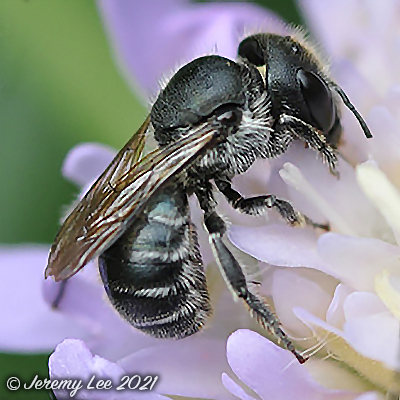
 |
|
Scientific Classifications explained » Amphibians » Ants » Aphids » Bees » Beetles » Birds » Bugs » Butterflies » Caterpillars » Damselflies » Dragonflies » Earwigs » Flies » Frog/Leafhoppers » Fungi » Galls » Grasshoppers » Harvestmen » Hoverflies » Lacewings » Ladybirds » Leaf Mines » Lichens » Mammals » Millipedes » Mosses » Moths » Sawflies » Slugs » Snails » Spiders » Trees & Shrubs » Wasps » Wild Flowers » Woodlice » Postboxes |
UK Nature > Bees > Osmia caerulescens

Scientific Name: Osmia caerulescens Common Name: Blue Mason Bee Osmia caerulescens, more commonly known as the Blue Mason Bee, is around 8 to 10 mm in length. The females (pictured above) have a blue metallic lustre to the abdomen giving rise to its common name, Blue Mason Bee, with black pollen-collecting hairs underneath. The males are bronze with pale yellow hairs and a shining slope at the front of the abdomen that distinguishes this species from other bees. Usually found around forest edges and clearings, flower meadows, orchards, parks and gardens. On the wing from April to August/September. Nests in holes, often existing cavities in dead wood and plant stems, rocks and mud walls. The female deposits her egg, adds food for the larvae, builds a small wall out of chewed leaves and creates the next chamber, where she will deposit the next egg. Widespread in England and Wales, but not usually occurring in great numbers, though more common in the south. |
|

https://www.uknature.co.uk is a website dedicated to showing the immense diversity of UK nature and wildlife. Our vast range of habitats, from lowland arable to snow covered mountains, from storm-ravaged coastlines to peaceful inland freshwater lakes and rivers, from dry, sandy heaths to deciduous and coniferous forests, all these habitats contribute to the abundance of UK nature. We have wild birds in huge numbers either residing or visiting our shores (597 recorded species as at July 2013) and we must also not forget the humble back garden with its grass lawns, flower beds filled with nectar rich flowers, shrubs and trees, all designed to attract huge numbers of insects such as bees, moths, butterflies and hoverflies; and finally the small ponds which provide safe havens for frogs, toads, newts and even slow worms and grass snakes. www.uknature.co.uk is the showcase for my personal passion, photographing uknature in all its glory. I sincerely hope you all enjoy the fruits of my labours. This site and all images contained therein is © Jeremy Lee 2004 - 2025. All Rights Reserved. Site design by Jeremy Lee. Site development & IT Support by Stuart Lee. |